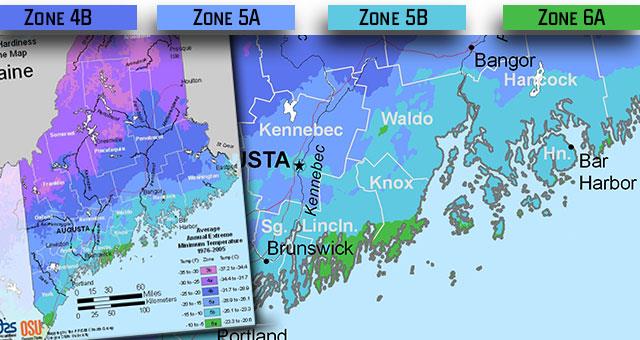The Hardiness
Zone Map
Hardiness zones were created to help home gardeners and nursery owners make informed decisions about what plants will perform well in specific areas. The US Department of Agriculture hardiness zone map has undergone many revisions through the years, most recently in 2012.

Hardiness zone maps use colored bands to give a good general guide to regional temperature differences, with about 10 degrees Fahrenheit difference from one zone to the next. For instance:
- Zone 5 is assigned to areas where the average Winter low is between -20 and -10 degrees F
- Zone 6 is assigned to areas where the average Winter low is between -10 and 0 degrees F (an average of 10 degrees warmer than zone 5)
- Zone 4 is assigned to areas where the average Winter low is between -30 and -20 degrees F (an average of 10 degrees colder than zone 5)
Each zone is further divided into subzones a and b, with the former being 5 degrees Fahrenheit cooler than the latter. Zone 5a Winter lows are between -20 and -15 degrees Fahrenheit, while zone 5b is -15 to -10 degrees Fahrenheit.
MAINE
Most of Maine is considered zones 4b, 5a, and 5b, although there are some area along the Midcoast and islands that touch 6a. The majority of Knox, Waldo, Lincoln and Hancock Counties are considered 5b.
The hardiness zone map is not infallible
Though efforts have been made to incorporate known microclimates into the updated map, the revised edition may not account for every nuance of every garden. The plant hardiness zones don’t take into account extreme weather patterns, so gardeners who are experiencing unseasonably cold or warm periods may experience some plant loss as a result.
Growers should keep in mind that some specimens that are said to grow in their zone may not necessarily thrive there. Many factors besides temperature may account for a perennial’s overall success or failure.

Play it safe
It’s important to take climate fluctuation into consideration when selecting trees, shrubs and perennials. All areas throughout the United States experience unusual highs and lows from time to time. Determine your Hardiness Zone then choose plants that are rated hardy for at least one Zone higher and one Zone lower to insure the plant will survive an unexpected extreme.
You can also protect more tender plants and trees from cold and snow load to give them a greater chance of making it through the Winter. Rose cones, stakes and burlap, mulching and moving to protected areas are all sensible precautions to take with favorite or valuable plants. We’d be happy to help advise on any protection you might want to use.
Use the USDA Hardiness Zone Map to determine your exact zone
Go to the website and click on your state. A detailed map of the state that includes major cities will pop up to show your zone.
Plants Unlimited
629 Commercial Street (Rt. 1)
(PO Box 374)
Rockport, ME 04856
(207) 594-7754
info@plants-unlimited.com
Hours:
7 Days a Week
7 Days a Week

